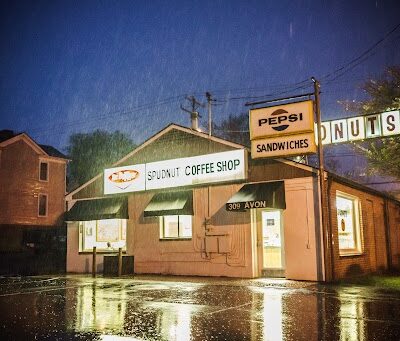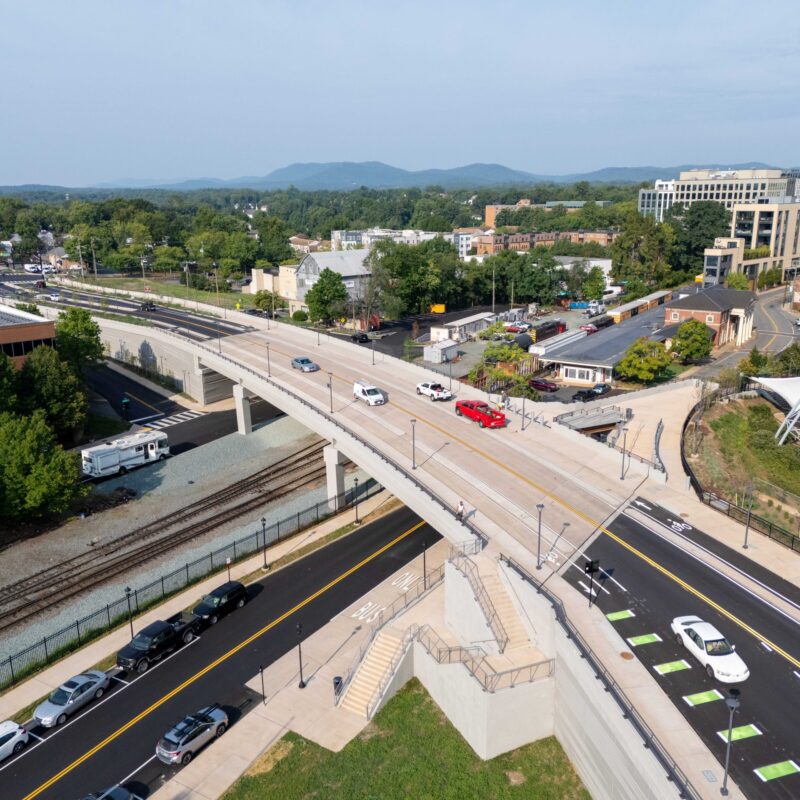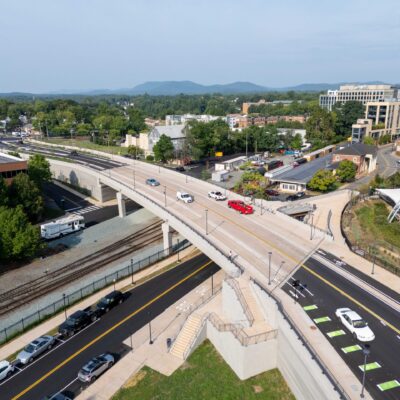When Gens. Robert E. Lee and Ulysses S. Grant first met in battle, it was in May 1864, at a site called Wilderness—just 50 miles northeast of Charlottesville. And the result of that meeting was some of the bloodiest fighting of the Civil War.
|
The intersection near the proposed site isn’t exactly pristine. There’s already a McDonald’s, a Sheetz, a 7-Eleven and a string of offices. |
The place is a densely forested tract of land located at the intersection of Routes 3 and 20. It is at this same intersection that Wal-Mart intends to build a 141,000-square-foot Supercenter, and it’s here that a different fight is shaping up, with preservationists against property-rights advocates in yet another quarrel over the development of historic green spaces.
“It was a horrific battle,” says Russ Smith of the National Park Service, “because for much of the battle the two sides couldn’t see each other, so it was very confused. Plus, part of the woods caught on fire, so wounded men were being burned alive during the battle.” Twenty-nine thousand men were killed, wounded, or captured at Wilderness in two days of inconclusive fighting.
|
Russ Smith, Superintendent of Fredericksburg and Spotsylvania National Park, stands at Ellwood, which dates back to approximately 1790. It is said that Robert E. Lee’s father wrote his memoirs in the house, and the fields surrounding the house were part of the Battle of the Wilderness. |
This “bloody draw” kicked off Grant’s Overland Campaign, marking the beginning of the end of the Civil War. Lee’s surrender came just 11 months later and 110 miles away at Appomattox on April 9, 1865.
That was nearly a century and a half ago. But a recent YouTube video, produced by Wal-Mart Watch, suggests that if both Lee and Grant were alive today, they’d be fighting on the same side. And their rival would be a formidable one: the world’s largest retailer.
In the video, the generals, back from beyond, pal around at the site of that first encounter:
“Needless to say, we weren’t exactly on the same side of things when we were alive,” jokes Grant.
“No, no we weren’t,” Lee replies. “Much blood was spilled over our differences. But upon one thing we agree.”
Grant: “We’re agreed that Wal-Mart should not build a giant Supercenter here at the historic Wilderness Battlefield in Virginia.”
Twilight zone
|
BATTLE FACTS Battle of the Wilderness May 5-7, 1864 100,000 Union soldiers 60,000 Confederate soldiers 29,000 casualties Inconclusive outcome; led to the battle at the Spotsylvania Courthouse a few days later |
Wilderness is one of four battlefields partially contained in the Fredericksburg and Spotsylvania National Military Park. Situated between Washington, D.C., and Richmond, Smith says this land was “the most fought over of the Civil War” with 100,000 casualties in the area.
Stonewall Jackson was shot by his own men just a few miles away at Chancellorsville, his amputated left arm buried at historic Ellwood Manor inside Wilderness Battlefield Park.
Historians consider Wilderness to be among the most significant battles of the war, for both South and North, evidenced by the fact that conservative Texas politician Ted Poe recently joined the state of Vermont in openly criticizing the proposed Wal-Mart development.
Not that Wal-Mart is buying up battlefield per se; the 55-acre plot of land is zoned commercial and has been since 1973. It’s situated on a ridge just opposite the National Park on Route 3, near a few other retailers about a quarter mile from the battlefield boundary.
But to many historians and preservationists, the idea of a Wal-Mart here is abominable for the site’s proximity to the park and for the fact that it’s within the historical boundaries of the battlefield.
“In 1993, Congress set up the Civil War Sites Advisory Commission (CWSAC),” says Russ Smith of the National Park Service. “Their job was to go out to the various battlefields and delineate the size of the battle on the land. They drew a line around the ‘core area’ where the most intense fighting took place, but the battles also involved a greater area…called the ‘study area.’ The Wal-Mart site is well within the study area and very, very close to the core area” of the battlefield.
The CWSAC ranked Wilderness a Priority I, Class A battlefield, its highest designation, and last spring, President Bush declared the swath of historic landmarks from Gettysburg to Monticello known as the “Journey through Hallowed Ground” a National Heritage Area.
Here in Albemarle, we’ve had our own laundry list of historic preservation battles over the years—you know, Rio Hill was a battlefield before it was a shopping center. Like 29N, much of Route 15’s “Journey through Hallowed Ground” has been compromised by strip malls and suburbs, stemming from population growth and D.C.’s ever-widening exurban sprawl.
But sprawl is a relatively new phenomenon in the largely rural and historically rich Orange County, and this particular development dispute is attracting national attention.
In December, 253 historians—Pulitzer Prize winner David McCullough, filmmaker Ken Burns, and UVA Professor Gary Gallagher among them—signed a letter to then-president Lee Scott asking Wal-Mart to build in a different location, one that would not alter “the very character of the battlefield.”
As of now it doesn’t look like that’s going to happen. Wal-Mart has submitted an application for a special-use permit (necessary for buildings over 60,000 square feet) to the Orange County Board of Supervisors and is awaiting its approval. Three of the five Supervisors support the permit, citing the commercial zoning and the concessions Wal-Mart has made to adapt its site plan and architecture to the historical surroundings.
|
Teri Pace, an Orange County Supervisor, opposes the Wal-Mart. "This is [Orange County’s] gateway," says Pace, "and it is paramount that we do not have our gateway symbolized by a generic big-box." |
A six-member alliance of regional and national organizations, called the Wilderness Battlefield Coalition, is mounting a counter-offensive. Not just against Wal-Mart but against what it sees as the inevitable repercussions: congestion, sprawl, and irreparable damage to an important piece of American history.
Adjacent to the Wal-Mart site, a 900-acre land parcel that’s up for rezoning threatens to lure smaller-box retailers once the Wal-Mart arrives. If that happens, says Orange County Supervisor Teri Pace (in whose district the Wal-Mart would be built) Wilderness will look increasingly like Culpeper, Fredericksburg, and Charlottesville, instead of providing a rural retreat from these centers.
Located at the Northeastern edge of Orange County, Wilderness is the county’s entry point for traffic coming from Route 15 (via Culpeper) and I-95 (via Fredericksburg) as well as its largest tourist attraction.
“This is our gateway,” says Pace, “and I think that as far as planning for future economic development and opportunity, it is paramount that we do not have our gateway symbolized by a generic big-box and the kind of generic commercialism that will evolve at that crossroads if we say that this is an appropriate place for Wal-Mart. Because it never stops there.”
With a sputtering economy and rising unemployment, it’s getting harder to have that kind of long-term perspective. The promise of added convenience, jobs, and tax revenue is winning local support for Wal-Mart. And, as Wilderness already demonstrates, it can be difficult to contain the spread of commercialism once it starts. What’s really at stake here, and what’s already been lost?
In the past four years, Orange County has experienced an enormous boom in tourism. The number of Wilderness Battlefield visitors increased 900 percent, from 171,000 in 2004 to over 1.5 million in 2008. In a few years, the country will commemorate the 150th anniversary of the Civil War. When battlefield tourists visit Wilderness then, what will they find?
Welcome to Orange County
“To be honest with you, I can’t wait for the Wal-Mart. Tomorrow would be great,” Kim Dodson tells me as she fills up on gas across the street from the proposed Wal-Mart site. “We get nailed at Bloom’s with the price of groceries there. We have to drive to Fredericksburg just to go shopping.”
|
Inside the office of his tire business, Orange County Supervisor Mark Johnson has a wall with the portraits of every U.S. president. He calls the proposed Wal-Mart “the continuation of how it’s been developed over the past 40 years.” |
Arnold Galyen, another gas station customer, says Wal-Mart would be a good thing. “They should have protected this area earlier. The damage has been done.”
Orange County Supervisor Mark Johnson agrees. He rejects preservationists’ argument that putting in a Wal-Mart at the intersection of Routes 3 and 20 would ruin the rural landscape around the battlefield.
“That horse left the barn a long time ago,” he says. “There’s a lot of commercial activity in that area, even closer to the battlefield. It’s not untouched; this [Wal-Mart] is basically the continuation of how it’s been developed over the past 40 years.”
Already there’s a Sheetz gas station, a McDonald’s, and a small strip mall with a Subway between the park boundary and the Wal-Mart parcel. Which prompts the question, how did that happen?
“Ten or 15 years ago there was a debate about whether a Sheetz and a McDonald’s should go in at that intersection,” Smith remembers. “Preservationists and others said that that’s not a good location and fought those things. The irony is now they are being used as an argument for further development.”
It’s a familiar quandary facing preservationists, especially in Virginia where battlefields outnumber, well, Wal-Marts: How do you stop commercialization once it starts? In other words, what if you don’t get there first?
One solution is damage control. Maybe you can’t kick retailers out, but you can try to make McDonald’s have smaller arches (which it does) and Sheetz look less like a spaceship (which it doesn’t).
Over the past year and a half, Wal-Mart has worked with preservationists and county officials on several architectural and landscape design changes to make the store more unique. “It’s not going to be the Taj Mahal or the Natural Bridge,” says Johnson, “but hopefully it will be more attractive than a standard big-box.”
Contrary to early site plans, Wal-Mart says the store will no longer be visible from the battlefield. “You won’t even be able to see it from Route 3,” according to spokesman Keith Morris. “What’s hard for people to realize is that the site we’ve chosen is 55 acres, and we’re only building on 19 acres. The rest of it is for landscape, and a sizeable chunk of it will be preserved.”
A spokesman for the National Trust for Historic Preservation, Robert Neiweg, says he disagrees with Wal-Mart’s position that the store will not be visible from the battlefield. He’s also concerned that resulting traffic congestion will necessitate the four-laning of Route 20 through a portion of the battlefield.
Supervisor Johnson says expanding Route 20 won’t be necessary. “It’s a busy road, but if you compare it with 29 going into Charlottesville for instance, Route 20 has still got a lot of capacity.”
Wal-Mart’s been in the spotlight recently for a couple of reasons: record sales last quarter, despite a global recession, and the company’s announcement that it’s laying off up to 800 employees at its Arkansas headquarters due to downsizing in the U.S. real estate division. Nonetheless, Wal-Mart created 33,000 American jobs last year.
In the face of declining employment and tax revenue, some in Orange County are just thankful to be on Wal-Mart’s radar. The new store could deliver up to 300 jobs and $500,000 in tax revenue.
“Like just about every other government in the world, we’re trying to figure out how to pay for things and not cut back services anymore than we have to,” says Johnson. “I don’t care what people think about Wal-Mart; the fact is they are growing right now.”
So is Orange County.
According to the Census Bureau, between 2000 and 2007 Orange County experienced an overall population increase of 25.5 percent. During the same period Virginia grew by 8.5 percent and the U.S. by 7.2 percent.
The county’s portion of Route 3 has already sprouted three housing developments west of the battlefield: Lake of the Woods (4,260 lots), Somerset Farm (275 lots), and Wilderness Shores (1,006 lots), which, according to Johnson, is consistent with Orange County’s long-term plan.
“Route 3 has been identified as a place where we wanted to direct development,” he says. “We’ll benefit from people coming in from other counties to shop [at Wal-Mart]. The county does need a tax space beyond residential.”
Of the four Wal-Marts within a 20-mile radius of Wilderness (three in Fredericksburg, one in Culpeper) none is in Orange County. Johnson wants to see some of that business stay local.
“We’re getting [our residents] to spend their tax dollars in Orange instead of in Fredericksburg or Culpeper.”
A different vision
Orange County’s vision statement reads: “Sustain and enhance the rural quality of life for Orange County citizens while improving their well-being.”
According to Supervisor Pace, embracing big-box retail at the expense of the county’s most significant historical landmark would “totally negate the vision statement.” She’s concerned that the Wal-Mart development is being seen as a quick fix instead of a long-term strategy to capitalize on Orange County’s rural and historic assets.
When it comes to the economic future of the county, Pace explains, “it’s important to capture a unique item or service—that’s what we have in Orange with agriculture, agri-tourism, niche farming, and a beautiful piedmont landscape. If we’re going to try to compete in the same market as Albemarle, Spotsylvania, Culpeper—if we’re going after the same kind of economic development—we’re not going to do so well.”
The Wilderness Battlefield Coalition aims to help Orange County devise a long-term sustainable development strategy. It’s offering $40,000, plus the use of its experts, to conduct a land-use study on how to avoid congestion, highway expansion, and damage to the county’s historic resources.
Instead, it hopes to: “Shield the rural character of the county and protect our historic and scenic resources from the undesirable effects of uncontrolled growth, thereby preserving the unique and distinguishing characteristics of Orange County”—a goal lifted straight out of the county’s own Comprehensive Plan, passed in 2005.
“All we’re trying to do with our dollars is help Orange County do now what it has known for at least the past four to five years that it should be doing for itself,” says the National Trust’s Neiweg.
So far the offer has not been accepted.
In an effort to keep Wal-Mart out of Wilderness, the National Trust is also working to invalidate the commercial zoning status of the land parcel, citing a 2001 provision to the Orange County stale zoning ordinance that requires landowners of commercially zoned property to act on the zoning within five years or the land will revert to its previous zoning, agricultural in this case.
Orange County has refuted the stale zoning charge, stating that the provision is not retroactive. But “they didn’t offer a legal basis for the position they’ve taken,” says Neiweg. “The fact that in 1973 the parcel was zoned commercial, it would seem to me to define the notion of stale zoning.”
Of course, there’s always the chance that Wal-Mart could decide to build elsewhere, something for which Supervisor Pace is advocating heavily. She says there are two other suitable sites further down Route 3, west of the battlefield, near the three housing developments: a 19-acre parcel adjacent to Bloom’s, and a 40-acre site near the entrance of Somerset Farm. At the latter site, Pace says traffic from both Somerset Farm and Wilderness Shores could access the Wal-Mart without ever using Route 3.
“That’s just smart planning.”
Supervisor Johnson, a proponent of the current site, is less optimistic: “I kind of think if Wal-Mart decided to move it down the road a mile or so, there’d just be another group that would oppose it. Maybe I’m cynical, but that’s kind of what I expect. They’re talking about moving it a mile or so down the road, not 10 miles away.”
As for Wal-Mart, it’s not considering any other sites at this time: “We’ve looked at other sites…through lengthy analysis. This site is planned for future commercial development,” says Morris. “This would be an ideal location.”
Old story
This may be the closest Wal-Mart has ever tried to build to a National Park, but there have been plenty of variations on the same theme.
Between 2004 and 2006, the Civil War Preservation Trust acquired 214 acres for the Chancellorsville Battlefield after developers put forth a plan to build an I-95 bypass and 20,000 homes on unprotected “core” battlefield.
Russ Smith of the National Park Service recalls how “the local community just came up in opposition to [the proposal]. It wasn’t just about preservation; a lot of it was about people coming down here to get away from Northern Virginia and Northern Virginia was coming to park on their front door.”
In 1996, Wal-Mart was criticized for planning a store near Ferry Farm, the boyhood home of George Washington in Southern Stafford, Virginia. After all was said and done, Wal-Mart moved a short distance away.
In the next few months, Orange County officials will hear from the public and decide the fate of the Wilderness Wal-Mart.
“At this point, a majority has said that they are supportive of it,” says Johnson. “But we have to let the process go ahead and play out, and we have to have the public hearings and then see where we are.”
Neiweg hopes the process is as transparent as possible for the public. “The Board of Supervisors’ taking positions at this point is premature; not all the information is available,” he says. “It should be up to Orange County residents.”
Across the street from the Wal-Mart site, in a small strip mall with a barber shop, Henry Flack waits for a haircut. When asked what he thinks the county should do, he replies:
“Wal-Mart is needed in this area as far as I’m concerned. It’s good for me, but I understand where the preservationists are coming from. I think it’s going to happen sooner or later, whether it’s Wal-Mart or something else.”
Maybe the commercialization of the Wilderness Battlefield isn’t inevitable, as Flack feels it is, but it’s certainly possible. Despite plenty of roadblocks—a weak economy, maturing “new urbanism” and anti-sprawl movements, a renewed interest in Civil War heritage and the “Journey through Hallowed Ground”—big-box retail still has plenty of momentum, and there’s a good chance Wilderness will become the next link in the Wal-Mart chain. What that would mean for the future of Orange County remains uncertain.
But Pace is sure of one thing: “I’ve never been anywhere where a Wal-Mart stands alone.”









